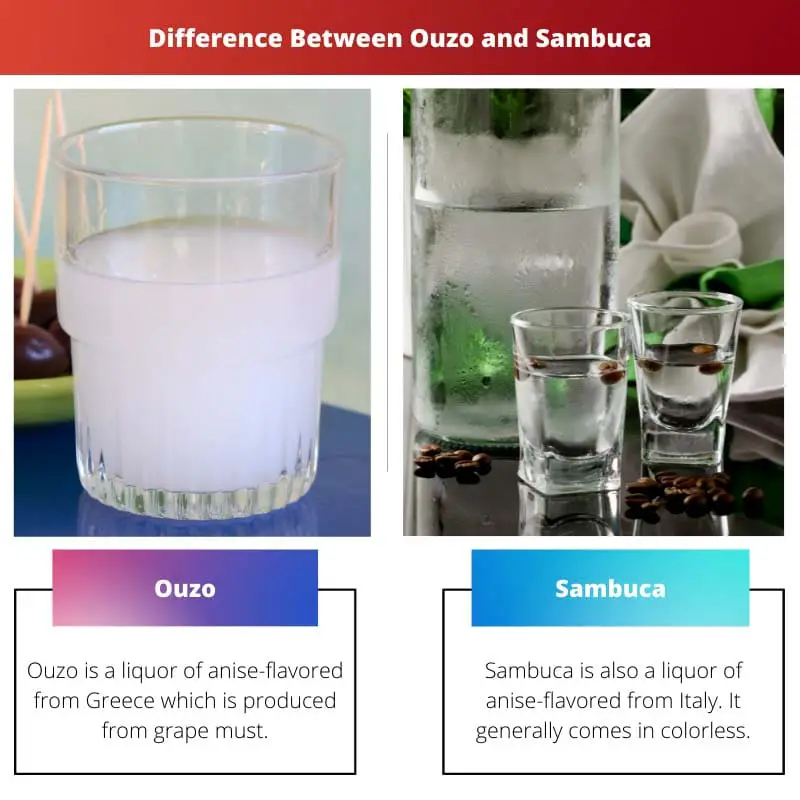There are endless varieties of vino in France. Fruity sangria is found in Spain. Pints of frothy Guinness is in Ireland. But when it comes to Mediterranean countries, such as Italy and Greece, what do they have?
In the bar, there are several options in this region of Europe, like anisette, chinchón, and pastis.
But among them, two of the most common are ouzo and sambuca. They both are made from a fragrant seed, namely anise, with a distinct flavour of licorice. Even though they both seem similar still they are quite different from each other.
Key Takeaways
- Ouzo originates from Greece and has a distinct anise flavor, while Sambuca hails from Italy with a sweeter, more intense licorice taste.
- Sambuca has a higher alcohol content, ranging from 38% to 42%, compared to Ouzo’s 37.5% to 50%.
- Ouzo turns cloudy when mixed with water, whereas Sambuca remains clear.
Ouzo vs Sambuca
Ouzo is a Grecian alcoholic beverage flavoured with anise and liquorice. The spirit is low in sugar content and has an alcoholic content of 40 percent. Sambuca is an Italian alcoholic beverage flavoured with anise. It is high in sugar content and has an alcoholic volume of 38 percent.

Ouzo is a liquor anise-flavoured from Greece which is produced from grape must. It may include spices other than anise. Greece and Cyprus are the only countries in which ouzo is made.
Ouzerias or ouzo bars serve it alongside meze (appetizers). Ouzo is gently diluted or simply drunk on its own. Sambuca is also a liquor anise-flavoured from Italy. It comes in colorless.
It is flavoured with essential oils, which are obtained from star anise and green anise (less commonly flows parenthesis). The most common variety of sambuca is white sambuca, which differentiates it from other varieties like black sambuca and red sambuca.
Comparison Table
| Parameters of Comparison | Ouzo | Sambuca |
|---|---|---|
| Interpretation | A Greek spirit with aniseed flavor. | An Italian liqueur with aniseed flavor |
| Origin | Greece | Italy |
| Alcohol content | 40 percent | 38 percent |
| Sugar content | Lower | Higher |
| Served | With simply icing over | With three coffee beans |
What is Ouzo?
Ouzo is an alcoholic spirit with an anise flavour. When the drink is diluted with water, it becomes cloudy, which is known as the ouzo effect. European Union recognized ouzo as the only protected designation with the origin in 2006.
According to the new appellation, ouzo from Greece and Cyprus only may use the name. High-quality ouzo may feature some aromatic properties. If ouzo is distilled from grain or grapes, it will have no change and taste.
Similarly, with the addition of sugar, it might be slightly sweet. Nevertheless, the dry mouthfeel will always be there due to anise. Ouzo can be overpowering and strong, but it is consumed neatly.
Traditionally, ouzeries or cafes ouzo serve it alongside mezedes. Most coastal areas and islands serve ouzo alongside fish due to its crisp flavour heightens the freshness.
In Greece, serving ouzo neat and well-chilled is considered a faux pas. According to some experts, firstly, water should be added to ouzo, then ice cubes, and the water should not be too cold.
According to the ancient Greeks, the anise helps to get relief from pain, reduced thirst, and difficult urination. The anise in ouzo gives antispasmodic benefits by elevating convulsions, diarrhoea, and cramps; the benefits can be gained in moderation, but the side effects of drinking too much can outweigh them.

What is Sambuca?
Sambuca is an Italian liqueur that is clear in look. Anise is the primary ingredient in it and is enjoyed after a meal. Nowadays, sambuca is associated with flaming shorts, but in the era of 1950s and 1960s, it was regarded as a symbol of the country, namely “La Dolce Vita”.
Sambuca is produced using neutral and pure base alcohol distilled, which is derived from either molasses or grain. Sometimes, the alcohol base is distilled at the local level, but it may be imported.
The ingredients of sambuca are star anise, sugar, and alcohol. Green anise is also used instead occasionally. In Italian custom, there are several ways to drink sambuca. Typically, it is rarely enjoyed drinking as neat.
At the very least, it is accompanied by three coffee beans. Alternatively, it may be diluted with ice water. When it comes to the cocktail ingredient, it is emerging as an excellent flavour to produce some exciting and original ones.
A shot of ouzo contains 100-110 calories, depending on the usage of sugar amount. Anise is well known for its digestion qualities. Because it settles the digestive tract, reduces flatulence, and decreases blotting. It is also used to treat bronchitis, asthma, and coughs.

Main Differences Between Ouzo and Sambuca
- Both ouzo and sambuca are made with anise, but ouzo is a Greek spirit with an aniseed flavor. On the other hand, sambuca is an Italian liqueur with an aniseed flavor.
- When it comes to flavor, ouzo is flavored with dry anise. On the flip side, sambuca is flavored with a star anise or green anise (less commonly).
- Ouzo is commonly mixed with water, and then it creates a distinctive cloudy and white beverage, while sambuca is also mixed with water but is placed on the side of espresso or poured into it.
- Ouzo is an aperitif spirit, which means that it is consumed before dinner, whereas sambuca is a digestif drink, which means that it is consumed after a meal.
- The benefits of ouzo are its antioxidant and anti-inflammatory characteristics that protect cells from diseases. But sambuca has vitamins and antioxidants which boost the immune system.




